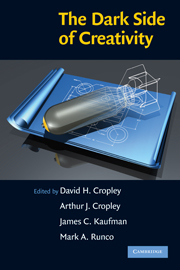Book contents
- Frontmatter
- Contents
- List of Contributors
- 1 The Dark Side of Creativity: What Is It?
- 2 Creativity Has No Dark Side
- 3 Positive Creativity and Negative Creativity (and Unintended Consequences)
- 4 Subjugating the Creative Mind: The Soviet Biological Weapons Program and the Role of the State
- 5 Imagining the Bomb: Robert Oppenheimer, Nuclear Weapons, and the Assimilation of Technological Innovation
- 6 The Innovation Dilemma: Some Risks of Creativity in Strategic Agency
- 7 Early Creativity as a Constraint on Future Achievement
- 8 Boundless Creativity
- 9 Reviewing the Art of Crime: What, If Anything, Do Criminals and Artists/Designers Have in Common?
- 10 Creativity in Confinement
- 11 Creativity and Crime: How Criminals Use Creativity to Succeed
- 12 So You Want to Become a Creative Genius? You Must Be Crazy!
- 13 Both Sides of the Coin? Personality, Deviance, and Creative Behavior
- 14 Neurosis: The Dark Side of Emotional Creativity
- 15 Dangling from a Tassel on the Fabric of Socially Constructed Reality: Reflections on the Creative Writing Process
- 16 Creativity in the Classroom: The Dark Side
- 17 The Dark Side of Creativity and How to Combat It
- 18 A Systems Engineering Approach to Counterterrorism
- 19 Malevolent Innovation: Opposing the Dark Side of Creativity
- 20 Summary – The Dark Side of Creativity: A Differentiated Model
- Index
- References
20 - Summary – The Dark Side of Creativity: A Differentiated Model
Published online by Cambridge University Press: 05 June 2012
- Frontmatter
- Contents
- List of Contributors
- 1 The Dark Side of Creativity: What Is It?
- 2 Creativity Has No Dark Side
- 3 Positive Creativity and Negative Creativity (and Unintended Consequences)
- 4 Subjugating the Creative Mind: The Soviet Biological Weapons Program and the Role of the State
- 5 Imagining the Bomb: Robert Oppenheimer, Nuclear Weapons, and the Assimilation of Technological Innovation
- 6 The Innovation Dilemma: Some Risks of Creativity in Strategic Agency
- 7 Early Creativity as a Constraint on Future Achievement
- 8 Boundless Creativity
- 9 Reviewing the Art of Crime: What, If Anything, Do Criminals and Artists/Designers Have in Common?
- 10 Creativity in Confinement
- 11 Creativity and Crime: How Criminals Use Creativity to Succeed
- 12 So You Want to Become a Creative Genius? You Must Be Crazy!
- 13 Both Sides of the Coin? Personality, Deviance, and Creative Behavior
- 14 Neurosis: The Dark Side of Emotional Creativity
- 15 Dangling from a Tassel on the Fabric of Socially Constructed Reality: Reflections on the Creative Writing Process
- 16 Creativity in the Classroom: The Dark Side
- 17 The Dark Side of Creativity and How to Combat It
- 18 A Systems Engineering Approach to Counterterrorism
- 19 Malevolent Innovation: Opposing the Dark Side of Creativity
- 20 Summary – The Dark Side of Creativity: A Differentiated Model
- Index
- References
Summary
Chapter 1 of this volume drew attention to a general failure by society to recognize the existence of the dark side of creativity. Subsequent chapters looked at the ways in which creativity can be manifested in forms that are neither positive nor beneficial. This dark side of creativity (McLaren, 1993) has attracted other labels, such as “negative creativity” (James & Taylor, Chapter 3 of this volume) and “malevolent creativity” (D. H. Cropley, Chapter 19 of this volume). (The difference between these two concepts will be discussed in greater detail below.) Leaving aside the precise meanings of the terms used, one thing is clear: Creativity can be and sometimes is used with the deliberate intention of causing harm or damage to others. Furthermore, even creativity that is intended to be entirely benevolent and positive in outcome may have unintended or unforeseen negative consequences – what begins with good intentions may end with harmful outcomes. To take an example, the discoveries of Jenner and Pasteur in the field of immunology, although extremely beneficial for all humankind, undoubtedly opened the door to the concept of biological warfare.
The dark side need not involve deliberate intent to do evil. People may have benevolent motives but be unaware of or unable or unwilling to anticipate the negative consequences of their creativity. Some creative workers with fundamentally benevolent intentions may even go so far as to blind themselves deliberately to the dark side of their work perhaps because of their fascination with or unquestioning belief in what they are doing, or their political or religious convictions, or through deception or coercion (see Zaitseva, Chapter 4 of this volume, and Hecht, Chapter 5 of this volume).
- Type
- Chapter
- Information
- The Dark Side of Creativity , pp. 360 - 374Publisher: Cambridge University PressPrint publication year: 2010
References
- 16
- Cited by

